The Restaurant Fryers Market is estimated to be valued at USD 552.7 million in 2025 and is projected to reach USD 953.0 million by 2035, registering a compound annual growth rate (CAGR) of 5.6% over the forecast period.
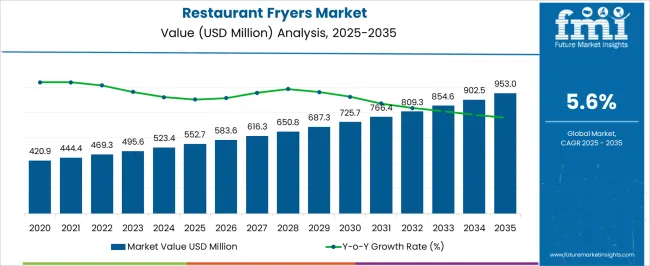
| Metric | Value |
|---|---|
| Restaurant Fryers Market Estimated Value in (2025 E) | USD 552.7 million |
| Restaurant Fryers Market Forecast Value in (2035 F) | USD 953.0 million |
| Forecast CAGR (2025 to 2035) | 5.6% |
The restaurant fryers market is experiencing consistent growth driven by the rising demand for quick service restaurants and evolving consumer preferences for fried foods. Increased consumer inclination towards convenience dining and the expanding foodservice industry have contributed to the widespread adoption of advanced fryer technologies.
Industry practices reflect a focus on energy efficiency, ease of use, and safety features, which are enhancing operational productivity in commercial kitchens. Future growth is expected to be propelled by the integration of innovative heating methods and automation to meet stringent food safety standards and reduce cooking times.
Additionally, the growing popularity of fried snack items and regional cuisine variations is encouraging product diversification. Sustainability initiatives focusing on reducing oil consumption and waste are also influencing product development and market expansion, establishing a strong foundation for long-term growth.
The market is segmented by Product Type, End-Use Application, and Type and region. By Product Type, the market is divided into Deep Fryers, Table Top, French Fryers, and Electric Fryers. In terms of End-Use Application, the market is classified into French-fried potato, Meat & Poultry, Fruit & Vegetables, and Fish & Seafood. Based on Type, the market is segmented into Tube Fryers, Ribbon Fryers, Rack Fryers, Flat Bottom Fryers, and Counter Top Fryers. Regionally, the market is classified into North America, Latin America, Western Europe, Eastern Europe, Balkan & Baltic Countries, Russia & Belarus, Central Asia, East Asia, South Asia & Pacific, and the Middle East & Africa.
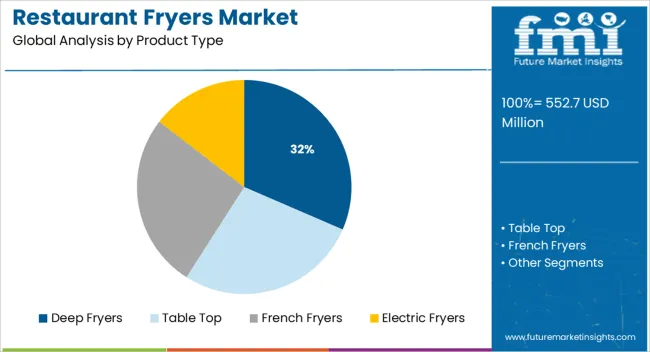
When segmented by product type, deep fryers are anticipated to hold 31.5% of the total market revenue in 2025, positioning them as the leading product type. Their dominance can be attributed to their versatility in handling a wide variety of fried foods, consistent temperature control, and capacity to maintain oil quality over prolonged usage.
Operational benefits such as faster cooking cycles and uniform heat distribution have made deep fryers preferred equipment in high-volume foodservice establishments. Additionally, innovations focusing on reducing oil absorption and improving energy efficiency have reinforced their appeal.
The adaptability of deep fryers across diverse restaurant formats, from quick service to full-service, has further driven their leading market share.
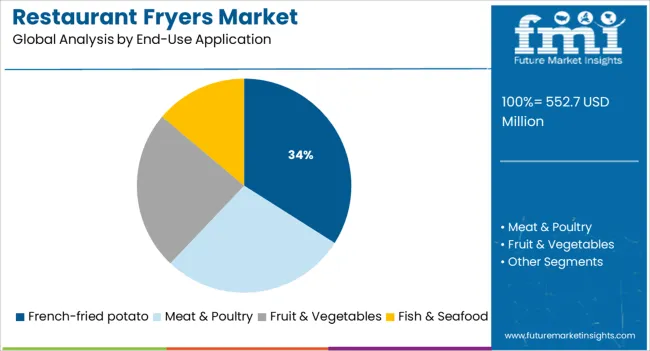
By end-use application, french-fried potato is projected to capture 34.0% of the market revenue in 2025, making it the foremost application segment. The popularity of french fries as a staple menu item across global fast-food chains and casual dining restaurants has been a significant growth driver.
Consistent consumer demand for crispy texture and taste has resulted in equipment designed specifically to optimize the frying process for potatoes. Moreover, the expansion of quick service restaurant networks and increasing snacking culture have contributed to the elevated use of fryers dedicated to french-fried potato preparation.
The segment's growth is further supported by continuous product innovation aimed at improving oil usage efficiency and reducing cooking times.
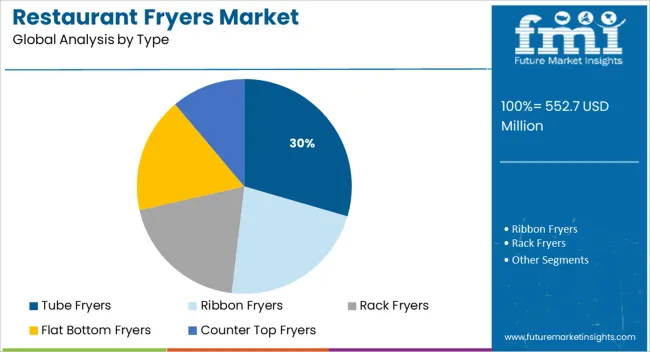
When segmented by type, tube fryers are expected to hold 29.5% of the market revenue in 2025, securing their position as the leading fryer type. Their design facilitates rapid heat transfer and high cooking efficiency, making them suitable for large-scale foodservice operations.
Tube fryers’ ease of maintenance and reliable performance under continuous usage conditions have made them preferred choices in commercial kitchens. Advancements in tube materials and burner configurations have enhanced their energy efficiency and operational lifespan.
The segment’s growth is also driven by the ability to handle various food products with consistent quality, reinforcing tube fryers’ dominance in the restaurant fryers market.
According to Future Market Insights (FMI), the global market value for restaurant fryers is expected to witness steady growth on the back of the growing consumption of deep-fried food products. With a rising preference for greasy, fried, and cheesy food products, hotels, and restaurants are using deep fryers and rack fryers to cater to the growing demand. Hence, key manufacturers are developing fryers with alarms and timers to gain revenue.
One of the important factors that are motivating restaurant fryers in growing is by giving customers a variety of foods with good taste and flavors. However, restaurant fryers are available in many models, technology, and prices in the market. The increasing health awareness of consumers and the introduction of oil-free diets to limit cholesterol levels in the body are fundamentally driving a great foundation for restaurant fryer products.
Further, the expansion of the hotels, restaurants, and café (HoReCa) industry and increasing preference for dine-out among consumers is providing an impetus to the demand. Quick-service restaurants are also largely responsible for the sales of fried food, propelling the production of restaurant fryers. However, with the advent of portable air fryers in the market, manufacturers might face some challenges over the upcoming decade.
A number of influential factors have been identified propelling the growth in the global restaurant fryers market during the projection period (2025 to 2035). Besides the proliferating aspects prevailing in the market, the analysts at FMI have also analyzed the restraining elements, lucrative opportunities, and upcoming threats influencing the restaurant fryers’ sales.
The drivers, restraints, opportunities, and threats (DROTs) identified are as follows:
DRIVERS
RESTRAINTS
OPPORTUNITIES
THREATS
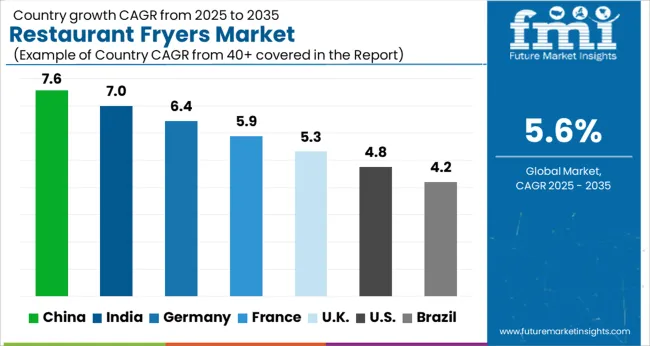
According to FMI, the restaurant fryers market in the USA is rising at a CAGR of 68%. Due to the increase in the level of health consciousness and demand from the USA and Canada, North America is likely to be the prominent market for restaurant fryers throughout the forecast period.
In India, restaurant fryers are likely to raise double-digit because of an increase in customer income and flexible lifestyle, and a rapidly rising population. The demand for an easier cooking experience and comfort among working women is a big factor in the market.
Even, without any disbelief restaurant fryers are upcoming in any kitchen setup. Major players are looking to establish their presence in the Indian market, with robust distribution channels to improve access to the local market.
However, favorable government support, financial options, and in addition, the presence of companies are expected to have a positive impact on the demand for restaurant fryers in china. On the back of these factors, the total market value of restaurant fryers in China is expected to reach USD 28.5 Million.
According to FMI, the demand for UK restaurant fryers is expected to rise at a CAGR of 22% over the forecast period. With increasing consumption of fried food such as fish fingers and beer, the demand for deep fryers in restaurants is expected to surge. As per the study, sales in the UK are projected to reach USD 43.6 Million.
However, innovative technology like 95% energy efficiency by induction, 13.7 L large capacity design, and the use of 3.5KW induction heating leads to a great foundation for the restaurant fryers market. The increasing number of growth opportunities in the market is attracting new players. The growth of the market is being driven by the increasing number of collaborations and acquisitions of smaller companies.
Deep Fryers to Remain Highly Sought-After among Restaurants & Fast Food Chains
Restaurant fryers are furnished with new features such as stainless steel in the oil drain and Omron thermostat control and fire risk and personal safety purpose. Preference for deep-fried food coupled with quick time and efficiency will drive the demand for deep fryers. However, with the rising health consciousness among people, the consumption of oily and greasy food has been reduced. This might hamper the sales in the market.
Further, electric fryers are more efficient when heating up and deliver quick heat recovery. Electric fryers have lower maximum oil temperatures and longer heat-up times. Restaurants that use electric fryers have the extra benefit of flexibility and in addition, it is transferable with plug-in and-go options and is more cost-efficient.
Restaurant fryers have a system to superheat the oil from medium to highest order when food products such as meat, vegetable, and potato are dropped into the oil. Because water and oil do not mix, the products do not lose moisture.
The restaurant fryer market is expected to be fragmented with the presence of numerous leading players, resulting in fierce competition in the market. However, key players are integrating new technologies to give innovative products and services and gain a competitive edge.
| Attribute | Details |
|---|---|
| Estimated Market Size Value in 2025 | USD 552.7 million |
| Projected Market Value in 2035 | USD 953.0 million |
| Global Growth Rate (2025 to 2035) | 5.6% |
| Forecast Period | 2025 to 2035 |
| Historical Data Available for | 2020 to 2025 |
| Market Analysis | USD Million for Value and Units for Volume |
| Key Countries Covered | USA, Canada, Germany, UK, France, Italy, Spain, China, Japan, India, Australia, South Korea, Australia, Brazil, Argentina, South Africa, UAE |
| Key Region Covered | North America; Latin America; Europe; Asia Pacific; Oceania |
| Key Segments Covered | Product, Type, Application, Region |
| Key Companies Profiled | Alto-sham; American Range; Fry-master; Combo food service equipment; Dragon food equipment; F&H equipment; Henny-penny; Hobart; Hoshizaki; Ice-o-Matic; Eware appliance; Lestov |
| Report Coverage | Market Forecast, Company Share Analysis, Competitive Landscape, Drivers, Restraints, Opportunities and Threats Analysis, Market Dynamics and Challenges, and Strategic Growth Initiatives |
The global restaurant fryers market is estimated to be valued at USD 552.7 million in 2025.
The market size for the restaurant fryers market is projected to reach USD 953.0 million by 2035.
The restaurant fryers market is expected to grow at a 5.6% CAGR between 2025 and 2035.
The key product types in restaurant fryers market are deep fryers, table top, french fryers and electric fryers.
In terms of end-use application, french-fried potato segment to command 34.0% share in the restaurant fryers market in 2025.






Full Research Suite comprises of:
Market outlook & trends analysis
Interviews & case studies
Strategic recommendations
Vendor profiles & capabilities analysis
5-year forecasts
8 regions and 60+ country-level data splits
Market segment data splits
12 months of continuous data updates
DELIVERED AS:
PDF EXCEL ONLINE
Restaurant POS Terminals Market Size and Share Forecast Outlook 2025 to 2035
Restaurant Equipment Market Size and Share Forecast Outlook 2025 to 2035
Restaurant Griddle Market Size and Share Forecast Outlook 2025 to 2035
Restaurant Glassware Market Size and Share Forecast Outlook 2025 to 2035
Evaluating Market Share in Restaurants & Mobile Food Services
Restaurants & Mobile Food Services Market Trends – Forecast 2025 to 2035
Analysis and Growth Projections for Restaurant Takeout Business
POS Restaurant Management System Market Size and Share Forecast Outlook 2025 to 2035
Used Restaurant Equipment Market Size and Share Forecast Outlook 2025 to 2035
Commercial Restaurant Rangers Market
Full-Service Restaurants Market Analysis by Model, Service, Location, and Region Through 2035
Commercial Gas Restaurant Ranges Market Size and Share Forecast Outlook 2025 to 2035
Commercial Electric Restaurant Ranges Market Size and Share Forecast Outlook 2025 to 2035
Airport Quick Service Restaurant Market Size and Share Forecast Outlook 2025 to 2035
Fast Food & Quick Service Restaurant Market Trends – Growth & Forecast 2025 to 2035
Gas Fryers Market
Gas Floor Fryers Market
Industrial Fryers Market Size and Share Forecast Outlook 2025 to 2035
Demand for Air Fryers in EU Size and Share Forecast Outlook 2025 to 2035
Gas Commercial Deep Fryers Market Size and Share Forecast Outlook 2025 to 2035

Thank you!
You will receive an email from our Business Development Manager. Please be sure to check your SPAM/JUNK folder too.
Chat With
MaRIA